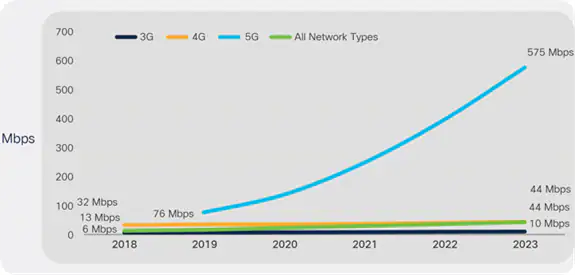We discuss the following topics in this blog:
- What Is 5G and Why Should You Care?
- So What Makes 5G and Voice Services a Perfect Pair?
- What Can We Conclude About the Future of 5G and Voice Services?
In addition to these topics, we shall also be answering the following FAQs:
- What is WiFi?
- What is a Data Centre?

Contents
What Is 5G and Why Should You Care?
5G is an acronym for the fifth generation of mobile networking infrastructure. It is the latest international standard after the 4G network. By leveraging the power of 5G, it will be possible to connect everybody, and everything, including machines, devices, gadgets; and this is just the tip of the iceberg.
It is no exaggeration to say that the trajectory of 5G technology is going to fundamentally change the way we live our lives. From enabling access to the masses to bolstering economic development the world over, 5G’s impact on our future is going to be nothing short of monumental.
Still not convinced? Here are some exciting yet informed predictions about 5G that might change your mind:
- As per Qualcomm 5G is intended to support a 100x expansion in web traffic and boost network efficiency immensely.
- According to tech specialists at CNET, around 1.5 billion individuals will have 5G access by 2024.
- As per a report published by Tech Republic, 35% of all mobile traffic will be enabled using 5G networks by 2024
- According to Forbes, 5G is well on its way to assist the self-driving automobile market to accelerate various economies’ development.

With the 5G wave just in the pipeline, voice services are going through an evolution that will facilitate more direct and natural voice interactions.
So What Makes 5G and Voice Services a Perfect Pair?
With 5G, it is extremely simple for developers to create highly advanced voice services than in 4G. It has allowed service providers to incorporate Augmented Reality (AR) within a phone call, upgrade video calling quality, and allow interactive calling for a truly immersive experience.
With the rise in this technology, there will be even more cutting-edge services, such as hologram communication and mixed reality, which is a blend of augmented reality and normal surroundings, to facilitate an uninterrupted user experience.
Following are some of the ways 5G is set to bring about a complete technological revolution:
Faster Data Speeds
5G technology will allow users to get high data speeds with extremely low latency, faster network capacity, and higher accessibility, leading to excellent reliability. The improved performance will enable a better user experience and speed up communication among various industries. It will enable you to download a movie within a matter of 10 seconds.

New Opportunities
5G services will create tremendous opportunities for Communication Service Providers (CSPs) to modernise voice services using new-age cloud programming and build a platform to develop new voice services. It is a golden opportunity to acknowledge cost savings through higher effectiveness and create new service revenue. Hence, the reasons to support the evolution of voice services are more vital than ever in the 5G era.
From the public sector to the manufacturing industry, every industry will undoubtedly see an application that 5G can empower or improve. It is possible only because of its high throughput, low latency, and enormous support for many devices in the upcoming years.
Future Proof Technology
With the advent of new 3GPP standards for 5G deployment, there is wider support for codec technology that enables multiple audio channels, provides immersive sound and opens new doors for virtual reality use cases. It will empower a scope of new and interesting 5G voice services, where users communicating with each other will have the option to be seamlessly immersed in each other’s environment.
These are real-time administrations, which require high-quality coverage to guarantee a decent user experience. There are new business opportunities to develop 5G networks in hospitals, factories, and mines, requiring critical low-latency broadband data services in conjunction with voice and correspondence administrations.
Seamless Experience
By adopting the 5G network, there will be a rise in the Quality of Service (QoS) upgrades, which incorporate lower latencies, faster data speeds, overall network accessibility, increased reliability, and less jitter. It will eliminate voice issues such as faltering, skipping, and dropped calls that users have faced for a long time with 3G and 4G networks.
Moreover, Ultra-Reliable, Low Latency Correspondence (uRLLC) 5G network for voice services will address average voice quality and latency issues. With Voice of 5G, a new voice codec will be used, which is gradually being used in voice-over LTE networks today. However, in 5G, it will ideally be the default voice codec. It implies that each user who purchases a 5G smartphone will have it by default. It will provide a more prominent voice quality experience than what HD voice offers in today’s age.
Another advantage of this voice codec is that the quality of music over a voice call will be much better when compared to the traditional HD voice technology. Think of music or audio announcements while you’re in the queue with a help desk.
5G’s greatest plus point is that it will handle latency issues around high-density regions that affect call quality significantly.
What Can We Conclude About the Future of 5G and Voice Services?
In the new 5G era, the voice will be more significant than ever. It will empower CSPs to address their venture clients’ issues who are progressively attracted to the agility and adaptability of Communications-as-a-Service solutions. They provide easy access to a large group of inventive abilities without the enormous capital required of traditional on-premise options.
CSPs will be able to provide their users with more vivid, natural, engaging face-to-face communication, along with human-to-machine communications empowered by voice assistants, chatbots, and voice-controlled IoT gadgets.
Voice services have traditionally been used for person-to-person communication. But with the 5G boom, person-to-machine communications will soon be a reality, and 5G will undoubtedly pave the way for our future.
FAQs
What is WiFi?
Put simply, WiFi is a technology that uses radio waves to create a wireless network through which devices like mobile phones, computers, printers, etc., connect to the internet. A wireless router is needed to establish a WiFi hotspot that people in its vicinity may use to access internet services. You’re sure to have encountered such a WiFi hotspot in houses, offices, restaurants, etc.
To get a little more technical, WiFi works by enabling a Wireless Local Area Network or WLAN that allows devices connected to it to exchange signals with the internet via a router. The frequencies of these signals are either 2.4 GHz or 5 GHz bandwidths. These frequencies are much higher than those transmitted to or by radios, mobile phones, and televisions since WiFi signals need to carry significantly higher amounts of data. The networking standards are variants of 802.11, of which there are several (802.11a, 802.11b, 801.11g, etc.).
What is a Data Centre?
A datacentre, sometimes referred to as a server farm, is a centralized physical location housing compute resources (high-end servers), storage (SSD, HDD, Flash, Optical), and networking equipment (routers, switches, firewalls, etc.) for collecting, storing, processing, distributing and allowing access to large amounts of data. Apart from the IT equipment data center also houses environment controls (airflow, humidity & temperature sensors), server racks, power supplies (backup systems, generators), and cabling systems (ethernet, copper, optical fiber). Initially, data centers were introduced to manage the large influx of service requests and store user-generated data. In contrast, it has now evolved to adopt technologies such as virtualization, cloud computing, mobile, Internet of Things (IoT) applications, machine learning, artificial intelligence (AI), and big data analytics.
There are four main types of data centers:
a) Enterprise data centers – Built, owned, and managed by a company for particular use-cases for their target user set. They are usually built on-site but can also be built away from the company premise.
b) Managed services data centers – Deployed, managed, and monitored by a third-party datacentre service provider for a company. The features and functionality can be accessed by the company using a managed service platform (MSP)
c) Colocation data centers – Consist of one data center owner selling space, power, and cooling to multiple enterprises and hyperscale customers in a specific location. The company focuses entirely on running the compute, storage, and networking equipment while the data centre service provider takes care of the space, power, cooling, security, and IT racks.
d) Cloud data centers- An off-site data centre provider such as Amazon Web Services (AWS), Microsoft Azure, IBM Cloud that stores the data of various enterprises. The data is fragmented and stored at various locations across the internet (i.e. datacentres across the world). This offers enhanced security, scalability, management, reliability, customization, and cost-effectiveness.














